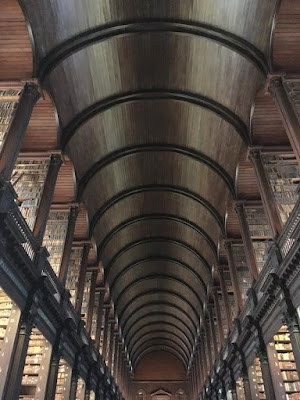I spent nearly an entire day at the Chester Beatty Library, and it was
absolutely worth it. It was even worth the sprint to Trinity College to see the Book of Kells, just before they stopped selling tickets for the day.
 |
| The Best Anteater Ever. |
I'm starting off with possibly my favorite illustration from the whole museum, even counting the many stunning Q'urans, Bibles, and painters' model books. It's an anteater! from a bestiary! Isn't he
charming? I love his frolic, I love his carefully detailed field of flowers, I love the pink sky and rolling green turf. Just delightful all around.
 |
| This isn't even one of the complex ones. |
The glass was a very good choice, because it kept me from drooling on the books. The gold work (and calligraphy, and fine pen detailing) in the Q'urans was just astonishing. As always, faith that manifests in art moves me.
 |
| I have enough photos of this single cover to make a little book. |
This cover isn't painted (or it mostly isn't painted)—it's got a fine leather filigree overlaid on the sections of gold leaf and blue. It's also
exactly the shape of cover I've been thinking was a fairly recent creation—standard codex shape, with a flattened pentagonal flap that closes over the front cover. Turns out, that's an old,
old design.
 |
| I like this calligraphic style especially, and the little colorful marks. |
This is a page from another Q'uran, more sparsely decorated, but with the name of god inscribed in gold. Unfortunately I didn't quite get the round decorations marking the intersections of verses into the photo, but they're interesting, too. The gold leaf is actually a small square, drawn over in black and blue ink to make an almost floral roundel.
 |
| Treasure bindings! Imagine if this was your default image of a 'book.' |
I got to see treasure bindings in person, and they are stunning! All that precious materials and skill to make a fitting cover for a book.
 |
| If there were a quarter on this book for scale, it would be the size of one of the music note dots. |
This choral is
massive, having been written for an entire choir to read from at once. Wonder who was in charge of turning the page?
 |
| Elephants! |
I also loved the wide variety of non-Western books and book-adjacent objects, though many of them didn't photograph well. These elephants are from a Burmese painter's model book—drawings they could use as references for future compositions to speed the process (and to avoid going and finding an elephant to model, I would imagine).
 |
| There's basically a whole story told in the margins of this one. |
Constantly delighted by marginalia of all kinds, but the little scenes in the margins of this painting of a
pari riding a composite animal—I'm serious, it's an animal depicted as being composed of a variety of other animals interlinked, chasing each other, sometimes eating each other—are just so lovely and fine. The composite animals seem like an artistic oneupmanship game to me:
"Oh, see, Rajan made his bull out of a dozen animals. Well, I'm going to use
two dozen for this
deer. Your move, Rajan!"
People are people, etc.
 |
| Glossy covers are very hard to photograph. |
And just to prove I do occasionally have interests in periods post-1200 C.E., here is an Art Nouveau/Deco (
I really don't remember and am not clear enough on the distinction to make it here) book cover of beautifully tooled and dyed leather.
Not pictured: the best of the best books, which were in a special exhibition and the only area off-limits for photos. I did sketch out a few of the letters and illuminations from the two 12th-century manuscripts in there, and hovered near the pages from the first known four-gospel Bible while a guard explained about the later addition of punctuation to make the text more readable, and how we know the pages were in a codex because of the clear fold lines and stitching holes still visible. There were a few jade books, with incised and gold-filled writing in slabs of beautiful clear or deep green-black jade, and some even-more-stunning-than-the-others Q'urans. Altogether an excellent place for someone like me to spend a day.
And then I zipped to Trinity College just in time to see the Book of Kells exhibit (also, alas, a photography-free zone). The Book itself is quite large, and the text and decorations
shockingly small. The little halos of red dots surrounding the illuminations are teeny. Pixel teeny. I think they must have been made with a single-haired brush.
Another of the four books in that exhibit had text with downstrokes maybe two millimeters wide, and all the letters were perfectly formed. I begin to understand medieval scribes' complaints about their aching hands and eyes.
 |
| I know everyone takes this photo, but it's just such a lovely space. |
I'm gonna haunt this library when I die. It's so
pretty. I love the intersecting barrel arches of the ceiling, and the light pouring in from the stacks is gorgeous.
 |
| This harp is about the size of my torso. |
And I got to stand near the purported harp of Brian Boru, and the model for the Irish heraldic harp, and take a photo that has approximately equal amounts of glare as the ones I used to take on school field trips with those little disposable cameras. The glass case didn't play well at all with the sunny day outside. It's a lovely shape (clearly), and
larger than I expected, from what's considered a lap harp. I'd love to hear it sounded.











Comments
Post a Comment